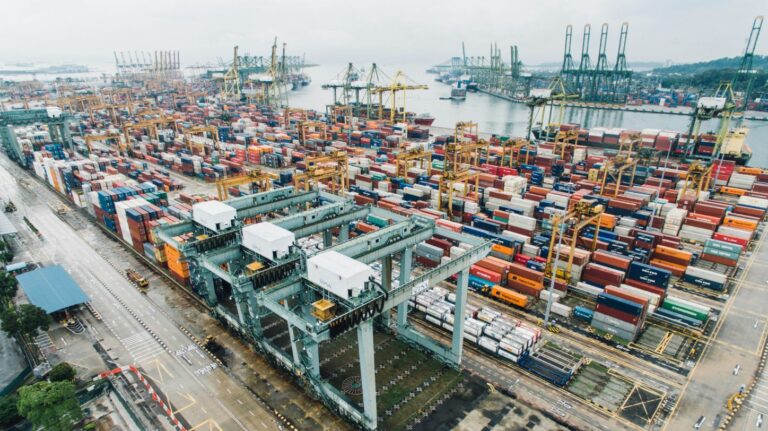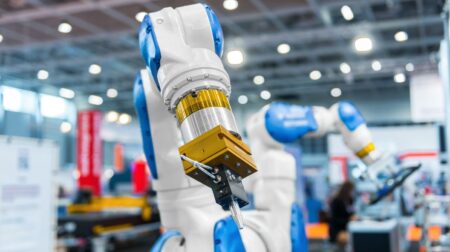The International Longshoremen’s Association (ILA) is facing a critical challenge in its ongoing negotiations with ocean carriers and employers over the future of automation in the shipping industry.
The focus of these discussions centres on the expansion of semi-automated rail-mounted gantry cranes (RMGs), a technology that the ILA argues could undermine jobs, national security, and the broader workforce. While the ILA supports progress and innovation, the union is determined to prevent the introduction of technology that it believes could put workers’ livelihoods at risk.
The ILA’s concerns are rooted in a history of lessons learned from past technological advancements. In the early 2000s, under a previous administration, the ILA agreed to the introduction of semi-automated RMGs at a new terminal on the East Coast.
READ MORE: Strike ends at US ports, wages agreed but negotiations on automation to continue
Employers at the time promised that the project would create thousands of jobs, presenting it as an opportunity for the workforce. However, the reality turned out to be much different. What was initially sold as a job-creating initiative has now become a model for automation that could eventually reduce jobs at many terminals along the East and Gulf Coasts.
A key issue that arose from the introduction of RMGs was a loophole in the Master Contract’s New Technology clause. While the clause required employers to notify the ILA of their intent to implement new equipment, it allowed them to proceed without fully considering the impact on the workforce.
As a result, the ILA’s members were left vulnerable to job losses without proper safeguards in place. By the time the 2012-2013 Master Contract negotiations came around, the ILA had learned from these early missteps and succeeded in securing stronger protections for workers. This included provisions that required the impact of automation on jobs to be taken into account before the technology could be introduced. In 2018, the ILA negotiated a ban on full automation, setting clear limits on the extent to which technology could replace human labor.
Despite these hard-won protections, employers are now pushing to expand the use of RMGs, claiming they are semi-automated and necessary for improving safety and productivity.
However, the ILA argues that in practice, the cranes are nearly fully automated. RMGs perform about 95% of their tasks autonomously, from lifting and stacking containers to moving them across the terminal. The only human involvement comes when a container is placed onto a truck chassis, but the ILA questions how long it will be before even that final step is automated. The union contends that this push for automation is less about enhancing safety and productivity and more about eliminating jobs under the guise of modernisation.
Additionally, the ILA has said that RMGs are not more efficient than traditional equipment operated by human workers, calling into question the employers’ claims about productivity gains.
The ILA’s opposition to automation also extends to concerns about national security and the broader economic impact. With ports becoming increasingly reliant on automated systems, they are vulnerable to cyberattacks that could disrupt operations.
Recent shutdowns at major ports due to technical glitches have highlighted how fragile these systems can be. The ILA warns that a cyberattack targeting port automation could cripple the US economy, potentially putting national security at risk. The union also highlights the threat posed by foreign-owned companies profiting from operations on US soil, claiming that these companies have little incentive to protect American workers or infrastructure.
The ILA has faced significant challenges in the past, particularly during the era of containerisation in the 1960s and 1970s, when the workforce in ports like New York and New Jersey shrank dramatically. The union fears that the current push for automation could lead to a similar reduction in jobs, leaving only a fraction of the current workforce in place. If the trend continues, the ILA warns that ports could be left with drastically fewer workers in the coming years.
Despite these challenges, the ILA has demonstrated a capacity to adapt to technological change. Since 2020, the union has helped achieve record cargo volumes while embracing new gate systems and terminal operating technologies. However, employers continue to argue that the ILA is obstructing modernisation. The union insists that it is not the workers, but the relentless drive for profit at the expense of workers’ jobs, that is at the heart of the push for further automation.
For the ILA, this fight is not just about protecting dockworker jobs but about defending the future of work in the United States. Automation, the union argues, poses a threat to all workers, whether blue-collar or white-collar, as Dennis A. Daggett, vice president of the International Logshoremen’s Association stated: “we cannot support technology that jeopardises jobs, threatens national security, and puts the future of the workforce at risk.”
As corporations seek to cut labor costs through automation and artificial intelligence, the ILA warns that a shrinking workforce will lead to fewer taxpayers, weaker communities, and an economy that relies more heavily on government support than on good-paying jobs. The ILA’s efforts are aimed at securing a future where technological progress does not come at the expense of the workforce that has long been the backbone of the U.S. economy.
 Join more than 11,000 industry leaders at Robotics and Automation Exhibition on 25-26 March 2025. Explore cutting-edge technologies, connect with peers and discover the latest innovations shaping the future of manufacturing, engineering and logistics. Register now to secure your place at this premier event!
Join more than 11,000 industry leaders at Robotics and Automation Exhibition on 25-26 March 2025. Explore cutting-edge technologies, connect with peers and discover the latest innovations shaping the future of manufacturing, engineering and logistics. Register now to secure your place at this premier event!








